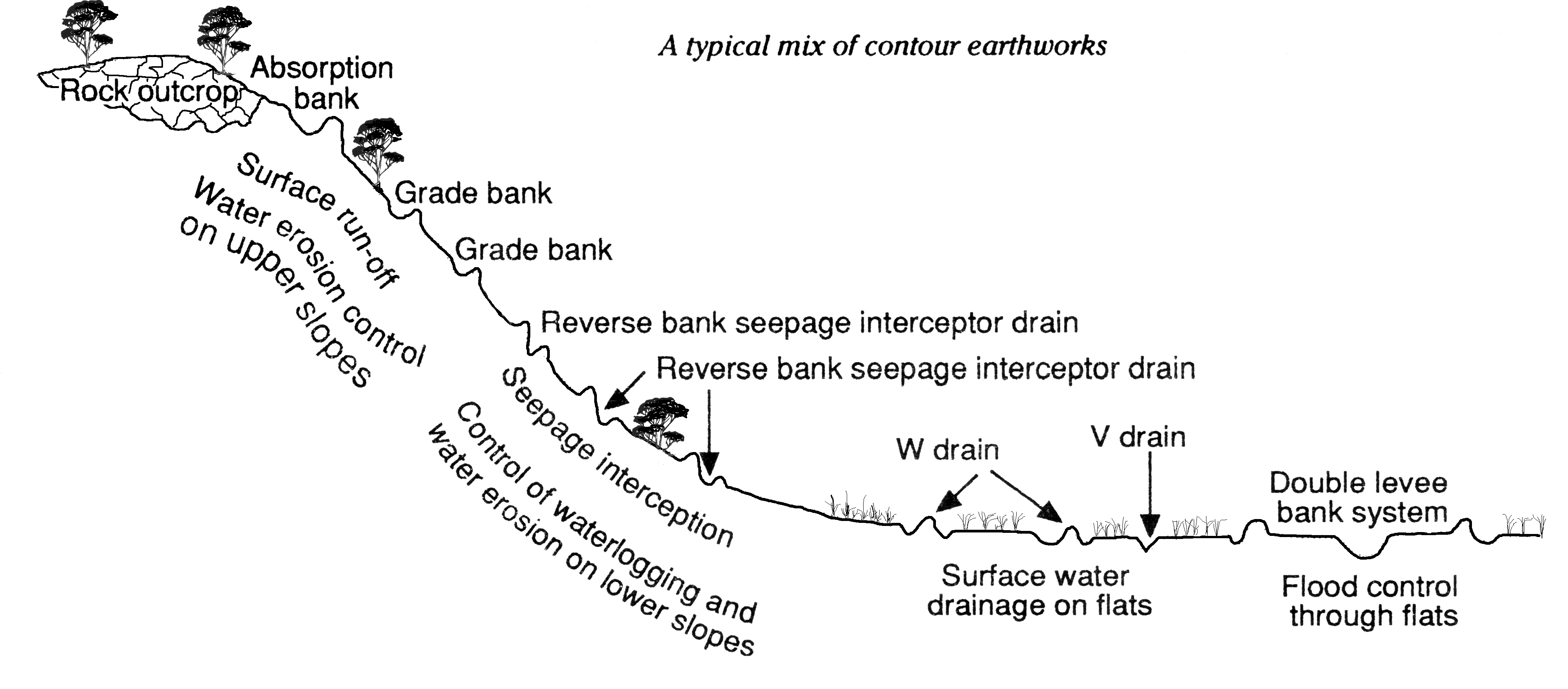Surface water management options used in Western Australia
The information in this table is only a guide – seek expert advice before planning, and use expert contractors for construction where necessary. Each landholder has a duty of care to make sure that flows from earthworks are not discharged indiscriminately on a neighbouring property and that stream flows are not significantly diminished or degraded.
See Conservation earthworks legal requirements of landholders for more information.
Please note, that any land degradation caused by any of these surface water management options is covered by the Soil and Land Conservation Act 1945.
Advantages of surface water management compared to subsurface drainage
- treats the cause of groundwater problems, rather then the problem
- cost of construction is relatively lower
- surface run-off water is usually of good quality and can be stored in farm dams or directed into natural watercourses
- water erosion and groundwater recharge are reduced
- peak stream flow in creeks is reduced, reducing flooding, channel erosion and sedimentation
- maintenance needs are low
- notification of surface water earthworks is not required under the Soil and Land Conservation Act (but subsurface drainage may be).
Environmental considerations
Waterways and wetlands in catchments are important for nature conservation and local ecology as well as local drainage and floodwater discharge. Avoid disturbing the normal patterns of flow and the natural water balance of existing ecosystems.
Integration in whole-farm plans
We recommend whole-farm water management as part of a farm plan. That is, land use, management systems and infrastructure need to meet the business goals and comply with legislation. In most cases, you will need a combination of surface and subsurface water management options to achieve a sustainable system with minimal degradation.
Before constructing any earthworks, seek expert advice to avoid technical, environmental and safety risks associated with water management.
| Earthwork | Land slope (%) | Soil type | Grade (%) | Landscape position | Purpose |
|---|---|---|---|---|---|
| Absorption banks and level banks | up to 10 | clay, clay loam, rocky | upper slope, below areas producing a lot of run-off | controlling run-off water where a grassed waterway cannot be safely maintained | |
| Grade bank | up to 10 | shallow duplex, loam | 0.2 to 0.5 | upper and mid-slope | controlling surface water erosion; harvesting water from slopes |
| Dams (excavated earth tanks) | up to 10 | clay, shallow duplex, deep duplex, loam | up to 10 | not in valley watercourse | storing and providing access to water for agricultural or household use |
| Roaded catchments | up to 6 | clay, shallow duplex | up to 6 | good clay required close to surface | improving water run-off from reduced catchment areas into dams |
| Grassed waterways | up to 10 | most soils | up to 10 | running downhill on a natural water accumulation line | providing safe disposal of overflow from dams or discharge from the end of grade banks |
| Seepage interceptor bank | up to 10 | shallow duplex, deep duplex, sand | lower and mid-slope | controlling shallow seepage and waterlogging | |
| Broad-based banks | 2 to 6 | shallow duplex, loam | 0.15-0.3 | upper, middle and lower slope | controlling surface water erosion; allowing easy vehicle traffic across banks |
| Shallow relief drains (W-drain, V-drain, spoon and spinner drains) | up to 0.2 | clay, shallow duplex | up to 0.2 | valley floor | removing surface water from flooded areas |
| Levee waterways | up to 10 | clay, sand, deep duplex, shallow duplex | up to 10 | valley floors and hill slopes | guiding and controlling the spread of water in drainage lines |
| Raised beds | 0.1 to 2 | 0.1 to 2 | valley floors and fairly level waterlogged areas | raising seed beds above the saturated soil of waterlogged areas | |
| Evaporation basins | site specific | holding saline discharge and preventing salt discharge to environmentally sensitive areas |
Layout of surface water earthworks



